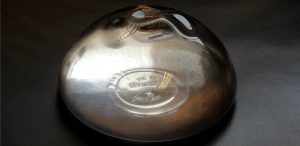Home|Blog | Why Are Silicone Implants So Much Better Than Saline Implants?
Why Are Silicone Implants So Much Better Than Saline Implants?
4 Minute Read:
After deciding that you want to have a breast augmentation, you may then be thinking about which type of implants you would want—silicone or saline? Then again, most women these days have already made their decision when it comes to selecting implants for their surgery—and their preferences are virtually always silicone.
However, if you have not made up your mind and are not very familiar with the silicone and saline pros and cons, there are several factors that you should consider when making your choice.
Of course, size and projection style (profile) are also quite important and impactful on your results.
There are two main categories of breast implants: silicone-filled and saline-filled.

What Are Saline Implants?
Saline implants have an outer shell constructed with a solid form of medical-grade silicone. Inside, they are filled with a sterile saltwater solution to provide volume. This is analogous to a high-tech, thick-skinned water balloon.
Benefits of Saline Implants
The main benefit of a saline implant is that it may be inserted before being filled. This means that a smaller incision can be used to insert the implant. Patients who get saline implants tend to have smaller scars as a result.
Another advantage of this design is that there can be a differential fill of the implants so that a difference in the size of a woman’s breasts may be at least somewhat addressed by placing different fill volumes in the implants.
Issues With Saline Implants
Saline implants do have significant downsides. When in the body, they will have a greater tendency to fold and wrinkle, resulting in unsightly ripples of the breasts. This situation is even worse when the implants are placed above the muscle, and/or the woman has little breast tissue or fat. Leaning forward can exacerbate this problem.
Generally, these implants also do not feel “natural” or anywhere near as natural as the silicone ones do after implantation. This is because they are filled with “thin” water versus the very viscous silicone that duplicates the natural breast feel.
Because of the different natures of saline versus silicone, the shell of the saline implants is at a much higher risk of developing a weakness, developing a hole or tear. To compound matters, when this does occur, the implant will usually deflate within a short period, and the body will absorb the saline, usually within a few hours. In contrast, when silicone implants break down, there is usually no change in overall volume.
Not only is this deflation embarrassing aesthetically, but it also costs real money to correct— surgical fee, outpatient center, anesthesia, and implants (if not under warranty) for breast implant exchange. This will make the cost of having saline implants far more than that for silicone ones. And, if it happens more than once…
Finally, saline implants cause more stretching and deformity of breast tissues over time than silicone ones. This is true whether the implants are placed in a submammary or submuscular location and worsen the larger they are.
What Are Silicone Implants?
Silicone implants have a tough yet flexible outer shell made of medical-grade silicone. They are filled with a cohesive silicone-based gel that simulates the weight and texture of natural breast tissue. Over time, vast technological changes and improvements have been made so that they are even more durable, safer, natural, and with many more nuanced options available.
Benefits of Silicone Implants
Silicone implants are far more durable and long lasting than their saline counterparts—a very important difference. They are also available in several round configurations—profiles—that allow for far more flexibility and options in tailoring the look and overall results that you are desiring. These silicone implants are also offered with different levels of gel cohesiveness, which can be quite advantageous in women with very thin skin or little breast tissue. The ultra-cohesive ones, in particular, are tremendously advantageous in women having breast reconstruction. Saline implants have no such options.
Silicone breast implants are far more popular and desirable and provide overwhelmingly more natural-looking, reliable, and superior results than saline.
Issues With Silicone Implants
The only real issue where silicone implants may be at a disadvantage when compared to the saline ones is when it comes to determining whether an implant is ruptured. With saline implants, there will be a deflation—a noticeable decrease in size often in a matter of hours. When silicone implants break down, there is essentially no discernible change of any sort—at least for a while. Typically, there is no change in shape, size, or feel, and there are no associated symptoms, which is why it can be very difficult to tell if they have ruptured. In order to make that determination, either a digital ultrasound or an MRI would be needed to make the diagnosis—though there are some false positives.
Of course, you can also consider this to be a positive since you don’t have to deal with the aesthetic emergency of a deflated breast that is usually also inconvenient as one has to with saline implants.
Interested in Learning More?
If you are considering breast augmentation surgery or a breast lift with implants, you can contact the Arizona Center for Breast Surgery to schedule your consultation with Dr. Turkeltaub by calling (480) 451-3000 or filling out our online contact form.
